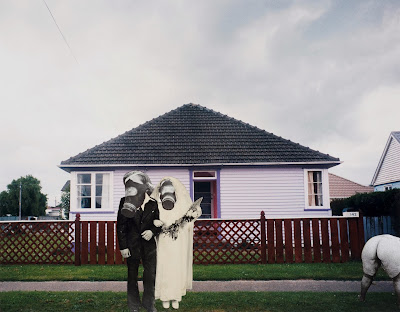The entire suite is currently on show in Natasha Conland's contemporary group exhibition Freedom Farmers. They have been glazed and framed and are exhibited as the original collages for the first time. Even though the entire artwork has a laudable notoriety it is still essentially under-known to the public.
Health, Happiness and Housing is a perceptive and astringent portrait of New Zealand. This country had lived through a period when Robert Muldoon devised his 'think big' projects while the population had comprehensive unemployment. The change wrung by fiascoes created because of the 1981 Springbok Rugby Tour led to a demonstrative population; one prepared to make loud statements about society neither cowered nor frightened by state authority. This is the time when War time baby boomers' children were young adults and expressing how they felt about life.
 |
| Dada Moon Dance |
 |
| G.I. Girls |
Devised initially as a social experiment in postwar housing, State Housing began profiling negative issues within community housing which had been unpredicted and unexpected. Seeing Health, Happiness and Housing was to see the unwanted. The series acutely reinforces the social reality of wealth versus poverty.
 |
| White Wedding, Invercargill |
 |
| Valley of the Fruitcakes |
Ava Seymour noted that New Zealand’s state housing project fostered "whole communities such as Otara and Porirua that became notorious and stigmatized for both their tenants and the appearance of their dwellings’ while further ‘depicting the dilapidation of such areas and the deterioration of our social dream."
Using her automatic fixed-focus Olympus camera, Ava recorded State housing communities at times when there appears to be a uniformly overcast sky. There may have been a blue sky on the day she visited, but Ava carefully manipulates the atmosphere to appear monochromatic and stifling.
Contrasting this shadow-less daylight is a local ‘population’ collected, sourced and derived from medical textbooks and magazines. This utilisation of such off-shore imagery is innovative for our art context. It makes foreign images relocate and immigrate to here. The people are both local and immigrant making this portrait more powerful than simply clipping from New Zealand printed sources. It also reduces recognisable sentiment and derides nationalism.
 |
| Betty and Nancy Gordon |
In contrast, Seymour’s humanity normalizes what we might previously have categorised as being images of freaks. We become the freaks by proxy and this provocation holds a mirror to us.
 |
| Corsophine Queen |
 |
| Welfare Mom |
 |
| Gas Mask Wedding |
 |
| Tea Time |
 |
| Day Care Walkabouts |
By being equally a critique and an affirmation, the sequence remains as challenging as it was a generation ago. In another generation it will still be regarded as tough and truthful. By shouldering images of real places with irreal inhabitants, Ava makes a social portrait which is fun, fearful and a lesson I am still being taught.
 |
| Minnie Dean |
 |
| House at Cannons Creek |
 |
| State Highway 1 |
 |
| Bandy Candy |
 |
| Enema Nurse |
Ava Seymour
Health, Happiness and Housing 1997
1. Dada Moon Dance
2. G.I. Girls
3. White Wedding, Invercargill
4. Valley of the Fruitcakes
5. Betty and Nancy Gordon
6. Corsophine Queen
7. Welfare Mom
8. Gas Mask Wedding
9. Tea Time
10. Day Care Walkabouts
11. Minnie Dean
12. House at Cannons Creek
13. State Highway 1
14. Bandy Candy
15. Enema Nurse
Photocollage
Auckland Art Gallery Toi o Tāmaki
purchased 2013
No comments:
Post a Comment